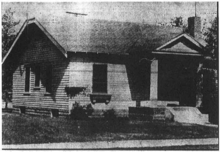Arthur and Edith Lee House
Arthur and Edith Lee House | |
 Arthur and Edith Lee House, 2014 | |
 | |
| Location | 4600 Columbus Avenue South, Minneapolis, Minnesota |
|---|---|
| Coordinates | 44°55′11″N 93°15′50″W��� / 44.91972°N 93.26389°WCoordinates: 44°55′11″N 93°15′50″W / 44.91972°N 93.26389°W |
| Area | less than one acre |
| Built | 1923 |
| NRHP reference No. | 14000391[1] |
| Added to NRHP | July 11, 2014 |
The Arthur and Edith Lee House is a historic place located in the Field neighborhood of Minneapolis, Minnesota, United States. It was originally constructed in 1923. In the early 1930s, Arthur Lee and Edith Lee, an African-American couple, acquired ownership of the home, which came during a period of racial discrimination in housing deeds, and the house was located in a predominately White neighborhood. The Lee family endured violent threats from White neighbors and eventually moved out of the house in 1934 after several years of unrest. The home had renewed interest in the 2000s from scholars of racial discrimination in housing and it was added to the U.S. National Register of Historic Places in 2014.
History[]
The home was built in 1923 and has similarities to kit houses common to the era.[1]: 4–5
In June 1931 the home was purchased by Arthur and Edith Lee, an African-American couple. At the time the surrounding area was considered to be a White neighborhood. Several years prior in 1927 hundreds of property owners in the area had signed a contract with the neighborhood association pledging to not sell or rent their property to non-Whites. When the Lees moved in July 1931 they were approached by the neighborhood association and offered more than they paid to sell the home back. After the Lees declined neighbors began to harass them by shouting threats and insults, posting offensive signs in their yard and throwing garbage and excrement on their lawn.[1]: 12–13

The unrest escalated over the next several days as crowds growing into the hundreds and later thousands continued their campaign of harassment by shouting slurs and throwing rocks at the home. Local police were sent to maintain the peace but offered little additional support to the Lees. On July 16 the Minneapolis Tribune broke a media blackout on the situation with a front-page story entitled "Home Stoned in Race Row."[1]: 13 Arthur Lee, a World War I veteran, was quoted in the article as saying "Nobody asked me to move out when I was in France fighting in mud and water for this country. I came out here to make this house my home. I have a right to establish a home."[2] The publicity from the article generated even larger crowds as well as onlookers. All available police in the city were called to form a cordon around the house and ensure nearby streets were not blocked by the mob.[1]: 14–15
Discussions with the neighborhood and community leaders during this unrest had been unproductive with the Lees' attorney advising them to say they were planning to leave to quell the unrest. The Lees were members of the local NAACP chapter and reached out to them for assistance. Lena O. Smith, the chapter's president, offered legal assistance and argued the Lees should remain as a statement that they would not be intimidated. The Lees accepted Smith's counsel and she drafted a statement published in all of the local newspapers noting that "[Mr. Lee] has no intention of moving now or later, even after we are assured the feeling in the district has subsided." Smith's assertive public statement combined with the strong police presence quelled the rioting.[1]: 16
The police presence remained at the Lees' house for more than a year thereafter; the Lees' daughter was escorted to and from school by police.[1]: 24 In 1934 the Lee family moved from the home to the historically black Central neighborhood in Minneapolis.[3]
Legacy[]
Interest in the home's history was renewed in 2001 when a law professor published an article on the Lees' second attorney, Lena O. Smith, including her role in the event.[3] The house was added to the National Register of Historic Places in 2014 on the basis of its significance to the social history of African Americans and housing discrimination in Minneapolis.[1]: 11
See also[]
- History of Minneapolis
- Housing discrimination in the United States
- List of incidents of civil unrest in Minneapolis–Saint Paul
- Redlining
References[]
- ^ a b c d e f g h "Arthur and Edith Lee House" (PDF). National Register of Historic Places. National Park System.
- ^ Welter, Ben (July 16, 1931). "Angry white mob surrounds Minneapolis home". Star Tribune. Retrieved June 28, 2020.
- ^ a b Brandt, Steven (27 July 2014). "Site of racial showdown in Minneapolis heading to National Register". Minneapolis Star-Tribune.
Further reading[]
- City of Minneapolis (April 6, 2021). "Arthur and Edith Lee House". Retrieved June 28, 2021.
- African-American history in Minneapolis–Saint Paul
- Houses completed in 1923
- Houses in Minneapolis
- Houses on the National Register of Historic Places in Minnesota
- National Register of Historic Places in Minneapolis
- Riots and civil disorder in Minnesota
- History of racism in Minnesota



